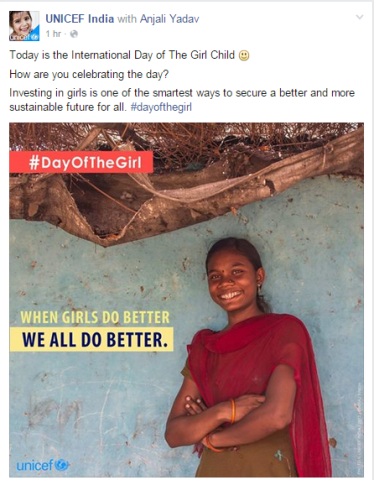International day of the girl child

11th October 2015; India is a nation of young people. Around 88 per cent of the world’s adolescents (between 10-19 years of age) live in developing countries, with India accounting for around 243 million, more than any other country. At the same time, India also is home to a large number of children suffering from malnutrition and otherwise preventable diseases.
The country is confident and reliant on the youth to enable the Government to help India achieve scaling heights. But what we are failing to achieve, despite consistent efforts, is a healthy and holistic life for women and children of our country.
Studies suggest that India is among the countries with high prevalence of anaemia across all age groups, particularly among 56% of female adolescents. In women, anaemia may even become the underlying cause of maternal mortality and perinatal mortality. It weakens women’s ability to survive childbirth, makes them more susceptible to infections, and leaves them with fewer reserves to recover from illness.
Girls in India traditionally eat last and least, this often leads to poorer nutritional intake thereby making them malnourished. This signifies that all these young girls are vulnerable to a host of diseases and problems if their nutrition levels are not optimized.
An adolescent girl who is well nourished is more likely to perform well in school and be more empowered as an adult woman than her poorly nourished counterpart, which enhances her family and child care-taking capacity later in life as a mother. She is also more likely to give birth to a healthy baby if she delays the age of marriage and pregnancy, and is already well-nourished. This in turn improves her child’s chances of survival, physical growth and brain development, with significant health and economic benefits across the lifetime, thereby breaking the intergenerational cycle of under-nutrition and poverty.
Taking cognizance of this, the Ministry of Health and Family Welfare has developed the National Guideline for Control of Iron Deficiency Anaemia to address both preventive and curative aspect of this challenge across all life stages and various levels of care. Therefore, MoHFW and UNICEF together came up with Weekly Iron and Folic Acid Supplementation (WIFS) programme that caters to both the adolescent girls in and out of school with a school based and an Integrated Child Development Services (ICDS) programme.
The magnitude of anaemia together with the associated adverse health, development and economic consequences, highlights the need for intensified action to address this public health problem.
Following a weekly iron and folic acid supplementation and an albendazole tablet in every six months religiously could help overcome anaemia easily. The WIFS Programme is actively working with the help of stakeholders like municipal school teachers, anganwadi workers, auxiliary mid wife nurses, doctors and ASHA across states like Uttar Pradesh, Madhya Pradesh, Andhra Pradesh, Odisha, Assam, Chhattisgarh, West Bengal, Jharkhand, Maharashtra and Rajasthan.
WIFS is an attempt to look at Iron Deficiency Anaemia comprehensively across all life stages including adolescents and women in reproductive age group who are not pregnant or lactating. The schedule of IFA supplementation has also been reviewed to make both administration and compliance much simpler.
The idea is to control iron deficiency anaemia in female adolescents so as to have better health outcomes to reach their highest potential. WIFS also aims to help India achieve millennium development goals with a decrease in the maternal and infant mortality rates.
UNICEF along with Ministry of Health and Family Welfare are doing their bit to make India anaemia free by creating awareness about healthy eating habits, consuming iron rich foods, IFA supplementation and correct cooking practices, which ultimately ends the intergenerational cycle of anaemia.
As a nation, Indians should come forward in evacuating anaemia from all age groups and help in building a strong nation of progressive and healthy young Indians.
